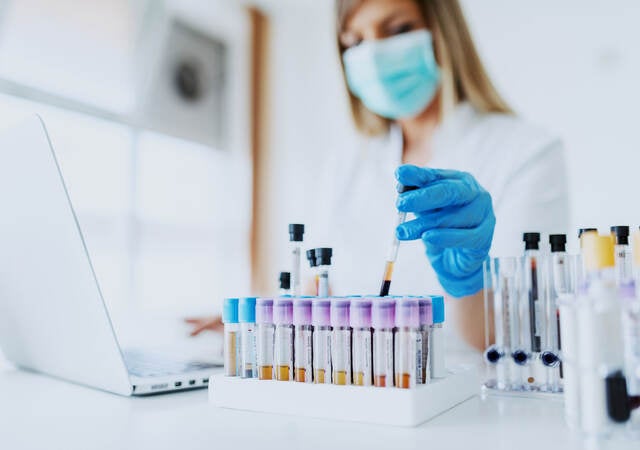Regulatory interest in the health and environmental impacts of per- and polyfluoroalkyl substances, known as PFAS, is escalating rapidly. These chemicals have been linked to a wide range of serious health topics, including birth defects and many types of cancer. PFAS do not break down over time and are colloquially referred to as “forever chemicals.” In 2022, Stockholm University released an alarming report that PFAS are even found in rainfall around the world1.
The packaging industry has used PFAS in materials that make contact with food, as these chemicals offer resistance to grease, water and heat. They are often found in materials used in fast-food and takeout containers, microwave popcorn bags, pet food bags as well as non-stick cookware.
As a global leader in safety science, UL Solutions prepared this handy guide for the food packaging industry to provide manufacturers with up-to-date answers regarding testing capabilities and constraints, regulatory progress and market access requirements around the world.
- What are PFAS?
PFAS is a large, complex group of manufactured chemicals — more than 10,000 substances. The Organization for Economic Co-operation and Development (OECD) defines PFAS as any substance that contains at least one fully fluorinated methyl or methylene carbon atom. The general properties of this class of chemicals include environmental persistence and mobility and the ability to be transported over large distances in the environment. Some PFAS are bio-accumulative, and other endpoints include reprotoxicity, immunotoxicity and neurotoxicity.
- Why are they banned?
PFAS are bioaccumulative, meaning they can build up over time. They are introduced into both humans and animals through the environment, soil, water, and air or through dietary intake from contaminated food and water. PFAS are also persistent and do not degrade over a significant timeline. While this alone does not indicate prohibition of PFAS, these chemicals are linked to various health risks in humans and animals, including cancer, hormone disruption, liver and thyroid issues, interference with vaccine effectiveness, reproductive harm, and abnormal fetal development.
- Where can they be found?
PFAS are found in a wide variety of consumer products that need to exhibit grease-, heat- or water-resisting properties, including non-stick cookware, takeout packaging, pet food bags and much more.
- In which countries and regions are PFAS banned or restricted specifically for food contact materials?
PFAS regulations are rapidly changing globally. Specific to the food packaging industry, the United States has state-based regulations that focus on PFAS as a class of chemicals rather than specific PFAS. Other countries and regions have current legislation that focuses on a select group of PFAS.
Summary of key regulations:
Location Regulation Scope EU
POP Regulation (EU) 2019/1021
Perfluorooctane sulfonic acid (PFOS) and its salts and related substances, Perfluorooctanoic Acid (PFOA) and its salts and related substances
Perfluorohexane sulfonic acid (PFHxS), its salts and PFHxS-related compounds
EU
Registration, Evaluation, Authorisation and Restriction of Chemicals (REACH)
C9-C14 perfluoroalkyl carboxylic acids (PFCA) and PFCA-related substances, Undecafluorohexanoic acid (PFHxA), its salts and PFHxA-related substances starting Oct. 10, 2026
USA
Various State Laws
PFAS
Canada
Prohibition of Certain Toxic Substances Regulations (SOR/2012-285)
PFOS, PFOA, C9-C20 PFCAs
China
中国严格限制的有毒化学品名录 (List of toxic chemicals strictly restricted in China)
PFOS and its salts and related substances
Japan
CSCL (Chemical Substances Control Law)
PFOS and its salts and related substances, PFOA and its salts and related substances
Perfluorohexanesulfonic acid (PFHxS)
New Zealand
Hazardous Substances and New Organisms Act 1996 (HSNO Act)
PFOS and its salts and related substances, PFOA and its salts and related substances
Perfluorohexanesulfonic acid (PFHxS), its salts and PFHxS-related compounds
- Does the European Union restrict all PFAS?
The European Chemicals Agency (ECHA) published a restriction proposal in February 2023, proposing a ban of all PFAS (approximately 10,000 substances), including precursors. If adopted, the ban will be implemented under REACH Regulation (EU) N0 1907/2006. The regulation will impact several industries including the textile, packaging, electric and electronic, food contact industries, and many more.
- Is the proposal restricting all PFAS in the EU also valid for the U.K.?
Due to Brexit, the U.K. will have its own UK REACH legislation that may diverge from EU REACH. Regarding restrictions on PFAS in the U.K., there is a proposal done by the U.K.’s Health and Safety Executive (HSE). Interestingly, under this proposal, the field of application may be different with the possibility of exemptions for fluoropolymers, and the number of PFAS covered by the restrictions may be fewer. Under the U.K. proposal, substances must contain at least one fully fluorinated methyl carbon atom or two or more contiguous perfluorinated methylene groups. In the EU, compounds with a single methylene carbon are also within the scope of the restriction proposal.
- Can you provide an update on the EPA's Toxic Substances Control Act recordkeeping and reporting rule?
On Oct. 11, 2023, U.S. Environmental Protection Agency (EPA) finalized the reporting and recordkeeping requirements for per- and polyfluoroalkyl substances under Section 8(a)(7) of the Toxic Substances Control Act (TSCA). The rule established a one-time reporting requirement for any entity that has manufactured or imported for commercial purposes at any time since 2011 a chemical substance, mixture or article containing PFAS.
The rule does not include a list of specifically identified substances. Rather, it applies to PFAS as a chemical category defined by molecular structure. More specifically, the rule defines PFAS as any chemical substance or mixture containing a chemical substance that structurally contains at least one of the following three sub-structures:
- R-(CF2)-CF(R′)R″, where both the CF2 and CF moieties are saturated carbons.
- R-CF2 OCF2 -R′, where R and R′ can either be F, O or saturated carbons.
- CF3 C(CF3 )R′R″, where R′ and R″ can either be F or saturated carbons.
The rule required reporting by entities that have manufactured PFAS or imported PFAS or articles containing PFAS between Jan. 1, 2011, and Dec. 31, 2022.
Unlike other TSCA reporting rules, the PFAS reporting rule includes no de minimus concentrations or production volume thresholds below which reporting is not required. Furthermore, it includes no exemptions for polymers, impurities, research and development, or small businesses.
The information to be reported includes:
- Company and plant site information
- Chemical-specific information
- Categories of use
- Manufactured amounts
- Byproduct reporting
- Environmental and health effects
- Worker exposure data
- Disposal data
All information must be submitted during the applicable submission periods, which run from Nov.12, 2024, to Nov. 10, 2025, for small businesses that are subject to reporting based solely upon the importation of PFAS-containing articles, and from Nov. 12, 2024, to May 8, 2025, for all other entities subject to the reporting requirements. Submissions must be prepared and sent electronically to the EPA using a PFAS reporting tool in the EPA’s Central Data Exchange. Also, submitters must maintain records that document information reported under this rule for a period of five years beginning on the last day of the submission period.
- What is the capability among service providers to measure total fluorine? How about the capability to test single PFAS and total content according to the limits of 25/250 parts per billion (ppb)?
Some laboratories can test for total fluorine. However, research on the detection limit for total fluorine in consumer products does not show levels as low as 25/250 ppb. The detection limit for total fluorine is typically 10 to 20 mg/kg. It is not known if any laboratory can test all 10,000 targeted PFAS using liquid chromatography/tandem mass spectrometry (LC/MS/MS) or gas chromatography/mass spectrometry (GC/MS).
UL Solutions laboratories and other providers will have a list of PFAS they can test for as targeted substances. For these targeted substances, it is possible to reach limits of 25 ppb as a single targeted substance and 250 ppb for the sum of target substances.
- Are there test methods that measure total organic fluorine derived from PFAS that exclude other substances containing fluorine? What is the specific method?
Currently, there are no standard methods for measuring total organic fluorine derived from PFAS that meet these criteria. Unfortunately, when screening for total fluorine, methods do not determine if the fluorine is specific to PFAS or another type of fluorinated substance.
- Specific to state-by-state regulations in the U.S., which results trigger a testing failure and require investigation or vendor comment?
Factors that trigger a testing fail and lead to an investigation or vendor comment depend on applicable regulations and client requirements. California regulations for total fluorine in plant-based food packaging stipulate that if the total fluorine is below 100 mg/kg, this will be considered a pass and not trigger an investigation. However, total fluorine content equal to or greater than 100 mg/kg will trigger an investigation or vendor comment.
- If I test for total fluorine, do I still need targeted PFAS testing?
This will be dependent on the regulations and the outcome of the test. Let’s stay with a California-based example: to demonstrate compliance with PFAS regulations for paper, paperboard and plant-based food contact packaging, no further testing is required if the total fluorine content is < 100 mg/kg. If testing for compliance in both the U.S. and EU, targeted testing will need to be performed based on REACH and POP regulations, as the criteria for these regulations is much lower than the detection limit for total fluorine analysis.
- Are the U.S. state regulations specific to only paper and paperboard and plant-based fibers?
Currently, approximately 20 states have prohibited PFAS in food contact materials. Some states like California specifically ban PFAS in paper and paperboard and plant-based fiber food packaging. Some states, including Connecticut, ban intentionally added PFAS in any food contact packaging or food packaging component, including paper, metal, glass and plastics. Other states have legislation requiring manufacturers of cookware sold in the state to disclose information on intentionally added PFAS found in the product’s food contact surfaces and handles. These regulations apply to electrical and electronic industry products such as electronic griddles, electronic fryers, electronic skillets, etc.
Please note that the state of California broadens this requirement to a designated list of chemicals that include PFAS.
How can UL Solutions help?
Demonstrating and maintaining compliance in a rapidly shifting regulatory environment can be challenging. UL Solutions offers food packaging manufacturers, brands and retailers a comprehensive array of services to help them understand and navigate PFAS regulations, plus chemical management services and expert guidance to help them mitigate compliance risk.
Our team of chemical professionals help develop a customized restricted substance list (RSL) to reduce the risk of noncompliant goods entering the marketplace. UL Solutions also offers industry-leading training products to help you stay ahead of regulatory changes and upcoming restrictions for PFAS.
As the world shifts away from PFAS, UL Solutions and the food packaging industry can work together to foster the growth of compliant products in the marketplace.
PFAS testing services for consumer products
UL Solutions can assist retailers and suppliers in finding the best testing and communications strategies for PFAS compliance along the supply chain.
Get connected with our sales team
Thanks for your interest in our products and services. Let's collect some information so we can connect you with the right person.






